Elvis Jiang
Overview
Gods and ghosts are always popular topics among all social classes in ancient Japan. Normal people use religious believes to explain natural phenomena that they cannot understand and help them defend against the imaginative eval spirits. Shogun and daimyo use myths and legends to demonstrate the legitimacy of their ruling. So, we can see there are a large number of traditional Japanese paintings including wood-block and Ukiyoe that is related with those topics. By taking a close look at those paintings, we could see how Japanese people view the world back to those days. It is also really interesting to see how did the artist in ancient japan turned their imaginations into specific paintings. In this exhibition, I want to introduce 3 paintings from famous artist in ancient Japan which can tell us how do people understand nature, interact with supernatural powers and fight against them.
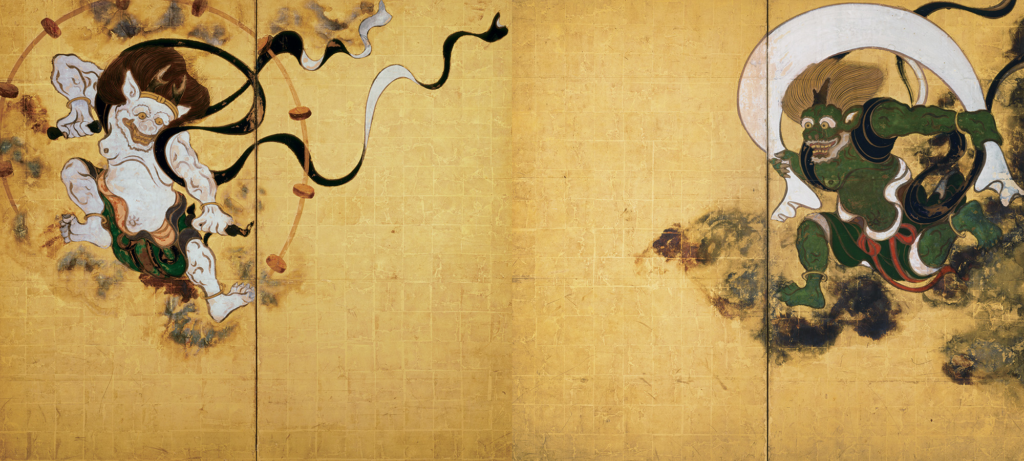
Title: Wind God and Thunder God
Artist: Tawaraya Sotatsu(1570-1643)
Type: Painting
Date: 17th century
Medium:Pair of two folded screens; Ink and color on paper covered with gold leaves
Dimension: 169.8 x 154.5 cm
Repository: A11189-1 Tokyo National Museum
The first one, Fujin raijin, The wind god and thunder god, created by Tawaraya Sotatsu, a famous painter during early edo period. It is a folded screen kept in Tokyo national museum. It is one of the Japanese national treasury. From this painting, we can see there are two scary gods on each side of the screen. Raijin and Fujin are among the most feared and respected Japanese deities. Adults sometimes tell children to cover their belly button when a storm approaches, because the thunder god could eat it! The thunder god on the left side uses hammers to beat those little drums to produce thunder and the wind god on the right side uses towels to produce huge winds. Farmers prey to the thunder god and wind god for rain in order to fertilize their land.Tawaraya uses smooth lines and floating curves to paint those two gods which makes them looks vivid. And the golden panels on the background makes the whole painting more gorgeous. Those two gods are also common figures in Japanese statues.
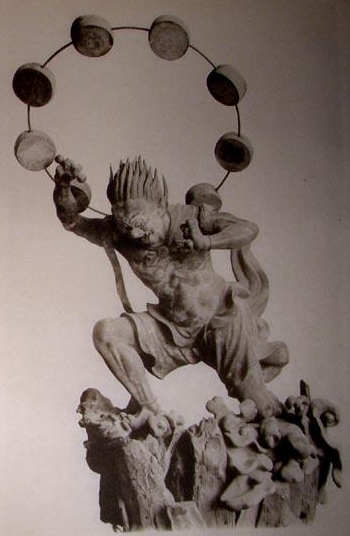
Title: Statue of Raijin in Sanjūsangen-dō
Type: Stone sculpture
Date: Mid 13th century, Kamakura period
Repository: Sanjūsangen-dō, Kyoto, Japan
Dimension: 1 meter tall
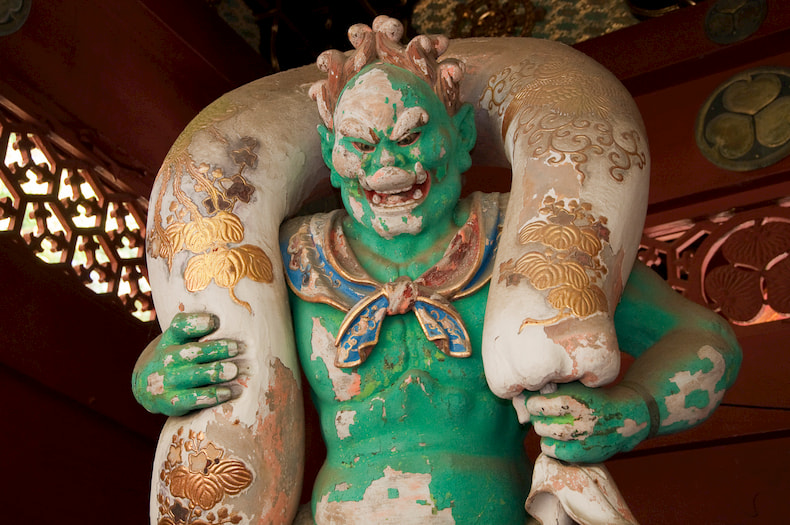
Title: Sculpture of Fujin in Rinnō-ji
Type: Stone sculpture with color
Date: Early Edo period
Repository: Taiyū-in Reibyō, Nikkō, Japan.
This stone sculptures of Fujin and Raijin looks very similar to their images on the painting. The two gods in both painting and sculptures are depicted as a scary gods with aggressive expressions. The wind god is painted in green and holding a big towel. But there are still some small differences. For example, you can see that different from the thunder god in the painting which has 5 fingers, the thunder god sculpture only have three fingers. Some says that it is how he controls past, present and future. For the wind god, he has flowing long hair in the painting. The hair and the fluttering towel accentuate the dynamics of the painting. But in the sculpture he stands still and has a different hair style.
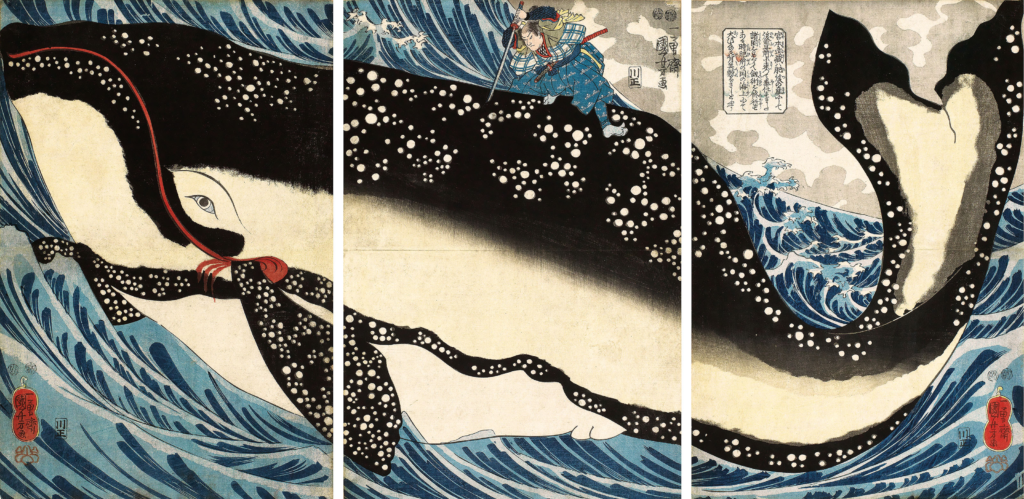
Title: Miyamoto Musashi Attacking the
Giant Whale
Artist: UTAGAWA KUNIYOSHI(1797-1861)
Type: Painting
Date: 1847 CE
Medium: Ink on paper with three separate panels
Dimension: 36 x 24.5 cm
The second one, Miyamoto Musashi attacking a giant whale off the coast of Higo, is created by Utagawa Kuniyoshi in late edo period. He is famous for this imaginative paintings and outstanding skills. In this painting, you can see the master swordsman Miyamoto is standing on the back of the huge whale and trying to plunge his sword into the whale. Beside the huge whale, we can also see the big wave is tossing. Different from other Japanese paintings that has a large area of white, this one is filled with color in every corner so I can feel the wave and the whale is going to jump out of the picture to the real world. The contrast between the size of the huge whale and the size of the person is trying to emphasize the bravery and strength. This graph is telling us that even human is so insignificance compare to the great power of the nature, we still have the strength to change the world.
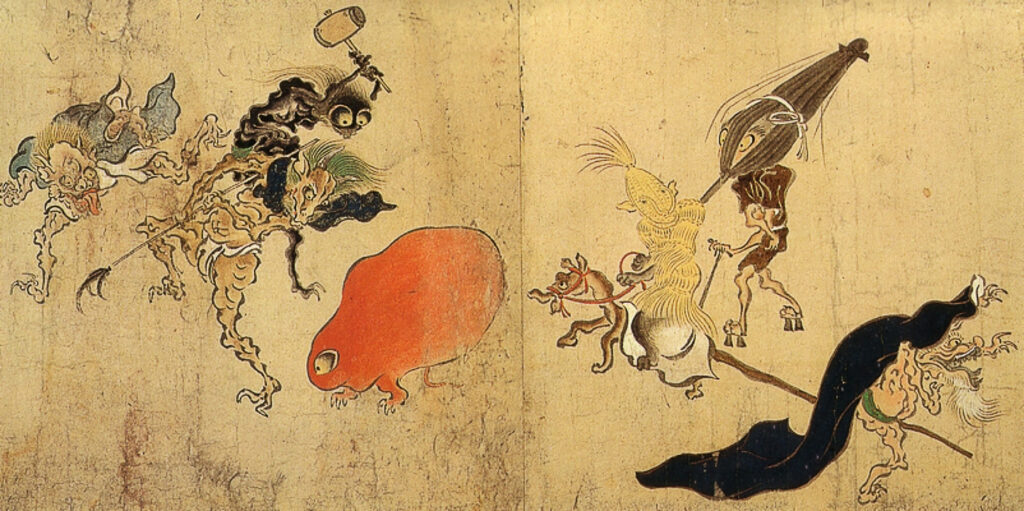
Title: Demons’
Night Parade
Artist: Unknown
Type: Painting
Date: Around 1700 CE
Medium: Ink on paper
Dimension: 36 x 24.5 cm
Repository: Japan National Diet Library Digital Collection NDLJP:2540972
Hyakki Yagyo, is an idiom in Japanese which means there are thousands of ghosts and monsters march through the streets at night time. In many ways, it resembles a traditional Japanese festival, filled with songs and chants, dancing, and merriment. This painting is trying to describe the scene of Hyakki yagyo. We do not know who created this painting, but it is created around 17th century in edo period. It is a collection in Japan Nation diet library. This is a really long painting, and here is one part of the whole painting. On the painting, we can see lots of strange creatures walking Hyakki Yagyo, is an idiom in Japanese which means there are thousands of ghosts and monsters march through the streets at night time. Those monsters are not from a single story but cumulation of folklores passed down from generation to generation. It is about breaking down of the barrier between the human and supernatural world. This painting is trying to describe the scene of Hyakki yagyo. We do not know who created this painting, but it is created around 17th century in edo period. It is a collection in Japan Nation diet library. This is a really long painting, and here is one part of the whole painting. On the painting, we can see lots of strange creatures walking on the streets. Some of the figures are from Japanese folklores. Some of the monsters are transformed from animals or vegetables. In order to show the weirdness of those ghost, the artist uses a large number of curves and color like orange which is not commonly seen on the ordinary creatures.
Different from other traditional paintings that are exquisite and delicate, those paintings about gods and monsters are striking and aggressive. I love how those artist uses their wonderful imagination to give those invisible creatures a concrete body.
Bibliography:
Images:
“Fujin Raijin.” Wikimedia Commons, Ninna-Ji Temple, Kyoto. Japan Times Https://Www.japantimes.co.jp/Culture/2015/11/03/Arts/Kyotos-Rinpa-School-Moving-Many-Ways/, 3 Nov. 2015, https://commons.wikimedia.org/wiki/File:Wind-God-Fujin-and-Thunder-God-Raijin-by-Tawaraya-Sotatsu.png. Accessed 15 Nov. 2021.
K, Ogawa. “Sanjusangendo Raijin Old.” Wikimedia Commons, Shimbi Shoin, Http://Www.baxleystamps.com/Litho/Sr/sr_2.Shtml, 1899, https://commons.wikimedia.org/wiki/File:Sanjusangendo_Raijin_old.jpg. Accessed 15 Nov. 2021.
Fg2. “File:Taiyuin-dsc3917.Jpg – Wikimedia Commons.” Wikimedia Commons, 18 May 2009, https://commons.wikimedia.org/wiki/File:Taiyuin-DSC3917.jpg.
“Category:Miyamoto Musashi.” Wikimedia Commons, https://commons.wikimedia.org/wiki/Category:Miyamoto_Musashi?uselang=it.
Tosa Mitsunobu. “Category:Hyakki Yako Emaki.” Wikimedia Commons, n.d., https://commons.wikimedia.org/wiki/Category:Hyakki_Yako_Emaki.
Texts:
Legend in Japanese Art: A Description of Historical Episodes Legendary Characterse, Folk-Lore, Myths Religious Simbolism. John Lane, 1908.
Paternoster, Michaël da Silva. “Raijin and Fujin: The Japanese Gods of Thunder and Wind.” Nipponrama, Michaël Da Silva Paternoster Https://Secure.gravatar.com/Avatar/0ece82c9698e1598033a79bbb151c5e1?s=96&d=Blank&r=g, 27 July 2019, https://nipponrama.com/raijin-and-fujin/.
“Yokai.com.” Hyakki Yagyō | Yokai.com, https://yokai.com/hyakkiyagyou/.